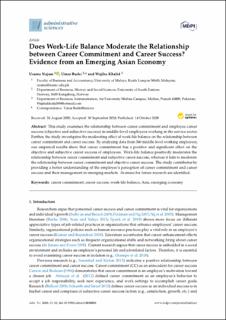| dc.contributor.author | Najam, Usama | |
| dc.contributor.author | Burki, Umar | |
| dc.contributor.author | Khalid, Wajiha | |
| dc.date.accessioned | 2022-04-06T10:52:13Z | |
| dc.date.available | 2022-04-06T10:52:13Z | |
| dc.date.created | 2021-04-13T14:38:07Z | |
| dc.date.issued | 2020 | |
| dc.identifier.citation | Najam, U., Burki, U. & Khalid, W. (2020). Does Work-Life Balance Moderate the Relationship between Career Commitment and Career Success? Evidence from an Emerging Asian Economy. Administrative Sciences, 10(4), Artikkel 82. | en_US |
| dc.identifier.issn | 2076-3387 | |
| dc.identifier.uri | https://hdl.handle.net/11250/2990159 | |
| dc.description.abstract | This study examines the relationship between career commitment and employee career success (objective and subjective success) in middle-level employees working in the service sector. Further, the study investigates the moderating effect of work-life balance on the relationship between career commitment and career success. By analyzing data from 360 middle level working employees, our empirical results show that career commitment has a positive and significant effect on the objective and subjective career success of employees. Work-life balance positively moderates the relationship between career commitment and subjective career success, whereas it fails to moderate the relationship between career commitment and objective career success. The study contributes by providing a better understanding of the employee’s perception of career commitment and career success and their management in emerging markets. Avenues for future research are identified. | en_US |
| dc.language.iso | eng | en_US |
| dc.rights | Navngivelse 4.0 Internasjonal | * |
| dc.rights.uri | http://creativecommons.org/licenses/by/4.0/deed.no | * |
| dc.title | Does Work-Life Balance Moderate the Relationship between Career Commitment and Career Success? Evidence from an Emerging Asian Economy | en_US |
| dc.type | Journal article | en_US |
| dc.type | Peer reviewed | en_US |
| dc.description.version | publishedVersion | en_US |
| dc.rights.holder | © 2020 by the authors. | en_US |
| dc.source.volume | 10 | en_US |
| dc.source.journal | Administrative Sciences | en_US |
| dc.source.issue | 4 | en_US |
| dc.identifier.doi | https://doi.org/10.3390/admsci10040082 | |
| dc.identifier.cristin | 1903820 | |
| dc.source.articlenumber | 82 | en_US |
| cristin.ispublished | true | |
| cristin.fulltext | original | |
| cristin.qualitycode | 1 | |

